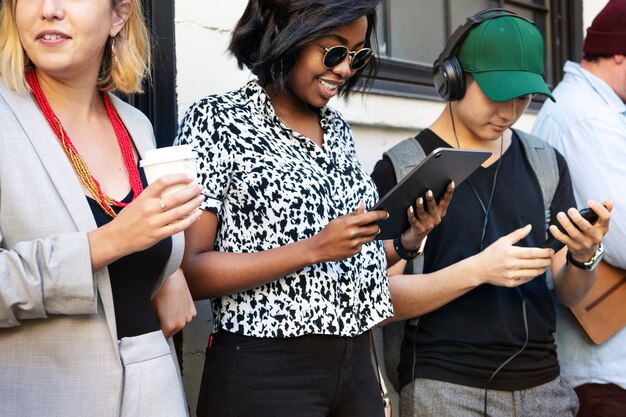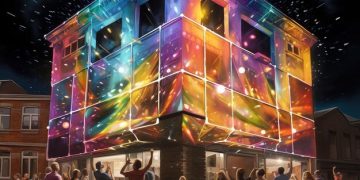From Broadway to TikTok: Democratizing Performance Art in America

From Broadway to TikTok: The Democratization of Performance Art in America explores how digital platforms are transforming performance art, making it more accessible and participatory for creators and audiences alike.
The world of performance art is undergoing a seismic shift. No longer confined to the hallowed halls of Broadway or elite institutions, the rise of digital platforms like TikTok is **from Broadway to TikTok: The Democratization of Performance Art in America**, fostering a new era of accessibility and creativity.
The Shifting Landscape of Performance Art
Performance art has traditionally been defined by its live, ephemeral nature and often limited accessibility. This is gradually changing, with digital platforms emerging as vital spaces for artistic expression. These platforms offer both performers and audiences new ways to interact, create, and experience art.
The Broadway Model: Exclusivity and Tradition
For decades, Broadway represented the pinnacle of performance art, a symbol of professional skill and artistic achievement. However, it also carried inherent limitations regarding cost, location, and access. Not everyone may be able to afford Broadway prices.
- High ticket costs limit accessibility for audiences.
- Geographical constraints exclude those not in major urban centers.
- Rigid production structures can stifle creative experimentation.
Broadway remains an important artistic institution, yet the digital realm provides a wider scope for exploring performance art.

TikTok as a Platform for Performance
TikTok is becoming a prominent arena for performance-oriented material and has become a dynamic arena for artists of all kinds to express their creativity and connect with a global audience. Its short-form video format and user-friendly interface make it easy for anyone to create and share their work.
Democratizing Access to Audiences and Creative Tools
TikTok’s greatest strength is its accessibility. Aspiring performers no longer need to navigate the complex structures of traditional arts organizations in order to access a large audience.
- Anyone with a smartphone can create and share content.
- TikTok’s algorithm promotes diverse content to a global audience.
- The platform offers a range of creative tools and filters.
These features combine to foster a culture of inclusivity and experimentation, allowing new voices to arise. The shift in performance art is one of accessibility on all levels.
The Rise of the “TikTok Star” and Performance Art
As TikTok gains popularity, so does the notion of a “TikTok Star.” These are performers who have amassed huge followings because of their creativity, ability to connect with others, and consistent material. They offer a fresh perspective on what it means to be a performer in the modern day.
Monetization of Art on TikTok for Performers
A major challenge for performance artists has always been monetary sustainability. TikTok presents many avenues for artists to be financially sustainable, including brand partnerships, virtual gifts, and direct contributions from devoted followers.
These chances not only give musicians financial stability but also reinforce the idea that performance art is a valuable and sustainable professional choice.

Blending Traditional and Digital Performance
The relationship between traditional and digital performance art isn’t adversarial. Many artists now seamlessly blend elements of both, creating hybrid experiences that push the boundaries of what performance can be.
Reaching New Audiences Through Digital Platforms
Traditional theaters and performance groups are understanding the value of digital platforms for extending their reach to new audiences.
Evolving Definitions of Performance Art
The rise of digital platforms prompts us to reconsider what actually constitutes “performance art.” The conventional concept of a live, in-person occurrence is being challenged by online streaming, virtual reality, and interactive installations.
- Virtual reality (VR) performances offer immersive, interactive experiences.
- Live streaming allows real-time engagement with audiences worldwide.
- Interactive installations blur the line between performer and spectator.
These advancements question what it means to participate in performance art, creating new prospects for creativity and audience participation. The line is blurred between performance and experience like never before.
Challenges and Criticisms
While digital platforms have democratized performance art, they also present challenges. Some critics argue that the short-form nature of platforms like TikTok can lead to superficiality and a focus on virality over artistic merit.
The Need for Critical Spectatorship
As performance art becomes more accessible, it’s increasingly crucial to foster critical spectatorship. Audiences ought to assess what they view and think about the impact and meaning of digital art.
The Future of Performance Art: Immersive and Interactive Experiences
Looking ahead, the future of performance art is likely to be increasingly immersive and interactive. Digital technologies enable artists to create experiences that blur the lines between the real and virtual worlds.
Embracing Technology While Preserving Artistic Integrity
The challenge will be to embrace these technologies while preserving the artistic integrity and emotional depth that define truly great performance art. New technology provides new opportunities for creation that never existed before.
| Key Point | Brief Description |
|---|---|
| 🎭 Democratization | Digital platforms make performance art accessible to a broader audience. |
| 📱 TikTok Influence | TikTok has emerged as a key platform for performance art, providing new avenues for monetization. |
| 🌐 Blending | Traditional theaters are integrating digital platforms to expand their reach. |
| 🔮 Future | The future of performance art is interactive, using immersion and technology for audience participation. |
FAQ
TikTok has made performance art more accessible by allowing anyone with a smartphone to create and share content. This removes traditional barriers to entry, enabling diverse voices to emerge.
Challenges include maintaining artistic depth amid the rise of short-form content and ensuring fair monetization for performers beyond the traditional Broadway model.
Traditional theaters are integrating digital platforms to expand their audience reach, creating hybrid experiences that blend live performances with online engagement. This allows them to stay pertinent.
Audiences are becoming more active participants through interactive installations and live streaming, blurring the line between performer and spectator. Also monetization options that did not exist before have evolved.
The future of performance art involves immersive and interactive experiences, using virtual reality and other technologies to blend the real and virtual worlds. This opens new avenues.
Conclusion
In conclusion, the shift of **from Broadway to TikTok: The Democratization of Performance Art in America** marks a crucial stage in the way that art is created, distributed, and experienced. While challenges remain, the possibilities and prospects for the future seem boundless. As these art forms continue to adapt, the key will be supporting creativity, promoting critical audience engagement, and supporting sustainable routes.





